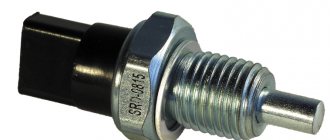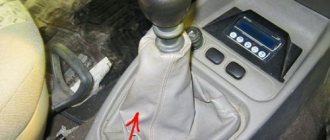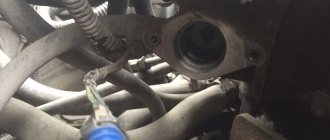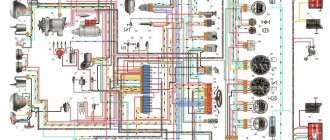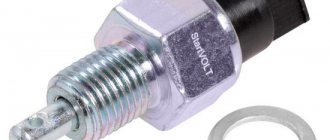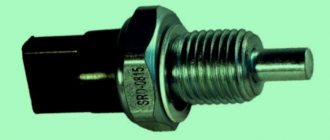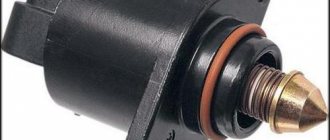The function of the solenoid is as follows: when we engage reverse gear and drive backward, the contact in it closes and the reverse lights come on, and a buzzer sounds in the cabin. However, sometimes it happens that we have turned off the reverse gear, are driving forward, but the buzzer continues to emit a signal and the reverse lights do not go out. In this case, it is necessary to replace the reverse gear solenoid . The opposite may happen: reverse gear is engaged, but the buzzer does not emit a sound signal and the lights do not turn on. In this case, you need to inspect the wiring near the solenoid connector. The reason may be rotten and torn wiring - it needs to be repaired.
In order to replace the reverse gear solenoid , jack up the front left wheel or lift the car on a lift. Remove the front left wheel. Remove the left side of the engine protection from the bottom of the car.
Then remove the electrical connectors from the solenoid. And from the speed sensor.
Using key No. 36, press the solenoid. And manually unscrew it from the gearbox.
We take a new solenoid and screw it into the transmission block.
Thanks for subscribing!
We clamp it. We put electrical connectors on the solenoid and speed sensor. Now you can check how it works. Turn on the ignition (do not start the car).
We turn on reverse gear, the buzzer and reversing lights work, turn it off and they stop. We assemble the car, install the wheel.
For stable engine idle operation, the Kalina idle speed sensor is designed. In this article we will talk about the Lada Kalina - about the characteristic features of the device on this car, what problems may arise and how to fix them, and recommendations for replacing the device will also be given.
Reverse sensor
Characteristics of the XX controller
Let's take a closer look at the XX sensor.
Purpose and principle of operation
The idle speed sensor is an electric motor with a conical needle of a certain thickness. This device is located on the throttle body next to the throttle position device, and is secured with two screws or using technical varnish.
The device has a single purpose: to stabilize the engine idle speed, and everything happens this way:
- When the engine is idling, a certain volume of air enters, which allows it to operate normally.
- The device does not read or control anything, it does what the ECU tells it to do. The unit controls, reads and, according to the tachometer readings, gives a command to the XX regulator.
- If you warm up the car engine to the optimal temperature, the controller will maintain speed. If it is not warmed up, then due to the operation of the IAC controller, the speed will increase. This manipulation will ensure the optimal engine temperature at higher speeds by analyzing the operation (author - RussianTuning).
Typical faults
Like any systematically operating device, the DXH may experience various problems, for example:
- The car suddenly stalls while idling.
- The DXX turnover is not systematic and “floats”.
- When starting the engine without preheating, the controller does not start working and the sensor does not rotate as it should.
- It suddenly stalls when changing gear on the gearbox.
- The DHW speed hangs after releasing the pedal or when activating various automotive equipment.
When all these strange things happen to a car, it is obvious that the problem lies with the regulator. Unfortunately, this device does not have self-diagnosis, so to figure out what exactly is the cause of the malfunction, you need to check it yourself. And if it can’t be fixed, then replace it. Replacing the idle speed sensor on Kalina will be covered below.
Also check out
- Fuse F21 is a 10A fuse in the fuse block, 8th from the left. Take it out and check it with a tester. If it is defective, replace it with a new one.
- Check the switch by lifting the cover on the handle. This will free up access to the connector connected to the switch. Disable it carefully.
- Using a paper clip, we close the contacts of the connector from which the wires are lowered under the floor of the car. Try to engage reverse gear. If this works, the switch is broken.
- Disconnect the connector from the solenoid and install 2 pins into it. Use a tester to change the voltage. The device readings should be 12 Volts. It is worth charging it with a light bulb (5 Watt or 12 Watt). If it does not light up, then there is an open circuit, and the voltage arises due to resistance formed due to copper oxide. Very often, breaks and fractures occur on the harness in the place where the clamp is located on the pallet.
- Remove the clamp by pressing its fastenings at the bottom.
- Disconnect the connector from the stop switch and remove the harness. Remove the electrical tape from the corrugation, after which you can remove the wires. In the event of a break or breakage, characteristic signs will be noticeable.
- Use wire cutters to disconnect the wires and connect them of similar cross-section and diameter. The twist should be soldered and insulated (you can use heat shrink). If necessary, put on a new corrugation. This is done so that moisture does not penetrate inside, otherwise it is possible that all the troubles will happen again. The harness should be secured with a plastic clamp.
- Connect the connectors and check the operation of the solenoid. Failure of this element is quite rare. To check it you need to connect a tester. The resistance should be 2.2 Ohm. If the cause of the malfunction lies there, you will need to drain the oil from the box. One option is to quickly block the hole with something and install a new solenoid. In this case, it is important to apply sealant to the threads so that oil does not ooze down the threads during operation.
Characteristics of the 3X sensor
Let's figure out what the 3X controller is!
Purpose and principle of operation
The reverse sensor on the Lada Kalina is located on the gearbox. The purpose of this device is to ensure that the rear lights turn off immediately when you stop reversing. The above-mentioned gearbox has a special coil installed that blocks reverse gear if problems arise with the sensor.
There is a ring on the gearbox lever with which reverse gear is given. As soon as this special part is lifted, a current charge is given to the coil, which draws in the coil core. These actions free up space for changing reverse gear. This pulse also signals the reversing indicators to turn on. If the headlights are turned off, the opposite situation is created when the core falls into place.
Location of the reverse gear
Typical faults
Lada Kalina is not a bad car, but there is one feature in it that completely spoils many of its advantages. This feature concerns the inclusion of reverse gear. The wiring on the gearbox is so thin and vulnerable that they can break at any moment if you do not handle them carefully.
There are other common problems:
- When you can reverse, but the light does not light up. If we are talking about one lamp, then the problem is with it and it will need to be replaced, if both do not light, you need to examine the circuit between the part and the lamps.
- Reverse indexing chain problem. In this case, you need to diagnose the ring on the gearbox.
- Often work stops due to the wires that lead from the sensor to the bottom of the machine, where the wire is affected by the environment and the contact can easily oxidize.
Restoring functionality
Reverse problems can occur throughout the reverse indication circuit. Therefore, you should not rush to drive the car onto an overpass and change the sensor. To begin with, it is worth checking out the more accessible places (but no less important).
Let's start with the ring on the gear lever. In principle, some craftsmen can easily disable both the sensor and the gearbox lock in 1 hour. But you shouldn't do this. This is not just a display system. It is also a security system. And since they did it (they didn’t save money on it), then this is a reasonable requirement. And any safety requirements, as you know, were written by those who neglected them.
The thing is that first gear and reverse gear are switched in the same way in the Lada Kalina: “toward and forward.” But the first speed is engaged simply, and the reverse with the help of a ring. Some protection “from accidents”. This is why you need a reverse sensor.
Reverse Controller Replacement Guide
To make a replacement, even an ordinary car enthusiast will need some skills and knowledge.
- First of all, the AC located under the car must be disconnected from the wiring.
- The switch must be carefully removed from the box and immediately replaced with a new one so that the oil does not leak out. Under no circumstances should you stand under the box, because oil can get on your face and clothes.
- It is best to let the car cool down a little before replacing, because in this case there will not be much pressure on the oil.
Reasons for the loss of reverse gear on the VAZ 1118
Idle speed sensor Lada Granta 8 valve
You need to lift the cover.
The wiring running from the gearshift lever to the solenoid is located on the Lada Kalina near the left side member under the bottom. Because of this, it is affected by water, snow, and reagents from the roads also affect its condition.
Long-term use of the car leads to rotting of the wire. The presence of voltage at the solenoid output is checked. If it is, then the wiring is broken, you need to inspect it for damage.
After the previous check, there may be a different result - there will be no voltage at the output. If the fuse is intact, it remains to ensure the integrity of the winding inside the solenoid.
For diagnostics, all wires are disconnected from the element and the voltage on them is checked. If so, the solenoid has burned out. Otherwise, the problem lies in the power supply in the area from the fuse to the lever.
To find out why there may be no reverse gear on a VAZ car, you need to understand what kind of design it is, what parts and assemblies it consists of. The reverse gears themselves are located inside the gearbox, in the housing, just like the speed selection mechanism, located outside the crankcase:
- two scenes (jet thrust);
- shift lever (RP);
- solenoid blocking the gearbox, screwed into the gearbox housing from the outside;
- locking ring located on the lever rod;
- switch located in the gearshift knob.
The reverse gear lock (RP) protects the gearbox from accidental engagement, and to engage the RG, you need to lift the locking ring up, first move the lever all the way to the left, and then move it forward. But sometimes it happens that even with the switch raised, the ZP refuses to work; the RP stubbornly refuses to take the desired position.
So, why doesn't reverse gear engage:
- there are defects on the gears of the gearbox;
- there is no normal clutch release;
- the spring on the axis in the speed selection mechanism broke;
- solenoid does not work;
- The sensor contacts do not close;
- there was a break in the wire supplying power to the blocker;
- fuse F21, responsible for the operation of the blocking device, has burned out.
The gearbox may not yet turn on if the link (thrust) is not adjusted, but in this case problems will also arise when trying to turn on some other speed (for example, first or fifth). That is why, whenever removing a manual transmission, it is recommended to put marks on the slide so that during reassembly it can be installed in exactly the same position.
Another reason for the malfunction of the gearbox is an unadjusted or poor clutch, but here, too, other gears either do not engage or shift with a crunch. The travel of the clutch pedal on Kalina is adjusted by decreasing or increasing the length of the cable; when the disc is worn out, the car begins to drive with slipping and does not pick up speed well.
Replacing the reverse light switch
Remove the left mudguard of the power unit (see “Removing the mudguards of the power unit”). From the bottom of the car, we clean the reverse light switch and part of the gearbox housing around the switch from dirt.
Disconnect the wiring harness from the reverse light switch. We close the contacts of the block with a piece of wire. If the reverse lights do not light up when the ignition is turned on, you should check the electrical circuit. And if the lamps light up, replace the switch with a new one
Using the “22” key, turn off the reverse light switch.
. remove it from the hole in the gearbox housing. . and immediately screw in the new switch to prevent oil loss. We check the oil level in the gearbox and, if necessary, bring it up to normal.
Checking the electrical wiring
If the current does not reach the lamp socket, you should check the rest of the electrical circuit in reverse order.
- Check your repair manual for the color and route of the reversing wires.
- Probe each wire along its entire length.
- In most cases the wire will disappear into the cable where you can't reach it.
- In this case, you should be extremely careful, because you risk damaging the working wire.
- Once you have identified the faulty section of the wire, remove it and install a piece of new wire in its place.
Important! Be sure to provide high-quality insulation at the wire connection points. The quality of the insulation primarily determines the reliability of the contact and the safety of the driver. You can also eliminate the possibility of a short circuit.
Video - Reverse gear does not light up on VAZ 2108, 2109, 21099. We are looking for the reason
A modern car is literally packed with electronics, and the Lada Kalina is no exception in this sense. On the one hand, electronics make life much easier for the driver. On the other hand, it can also become a cause and source of headaches for the driver, since the abundance of electronics can seriously complicate troubleshooting. The most common electronics-related problem on Kalina is the inability to engage reverse gear. We will tell you why the transmission does not turn on and how to fix it in this article.
How does the system work in Kalina?
The gear selection lever of the Lada Kalina transmission is equipped with a special ring. If you do not lift it, it is impossible to activate reverse gear. The lifting of the element is accompanied by the application of a certain electrical impulse to the coil. As a result, the core is drawn into the coil, which allows the transmission to be engaged. The same pulse generates a signal to activate the reverse movement indicator.
In the reverse process, the core is installed in its original place. Here, a pulse is also generated inside the coil, which enters the control system for the stern lighting devices. As a result, the lamps responsible for reverse gear turn off. Structurally, the reverse switch we are considering is located on the bottom of the transmission housing. Wires go to it. It is these components that become the reason for damage, since this arrangement creates a risk of touching uneven road surfaces. Breaks of patch cables are quite common here, as evidenced by many reviews.
